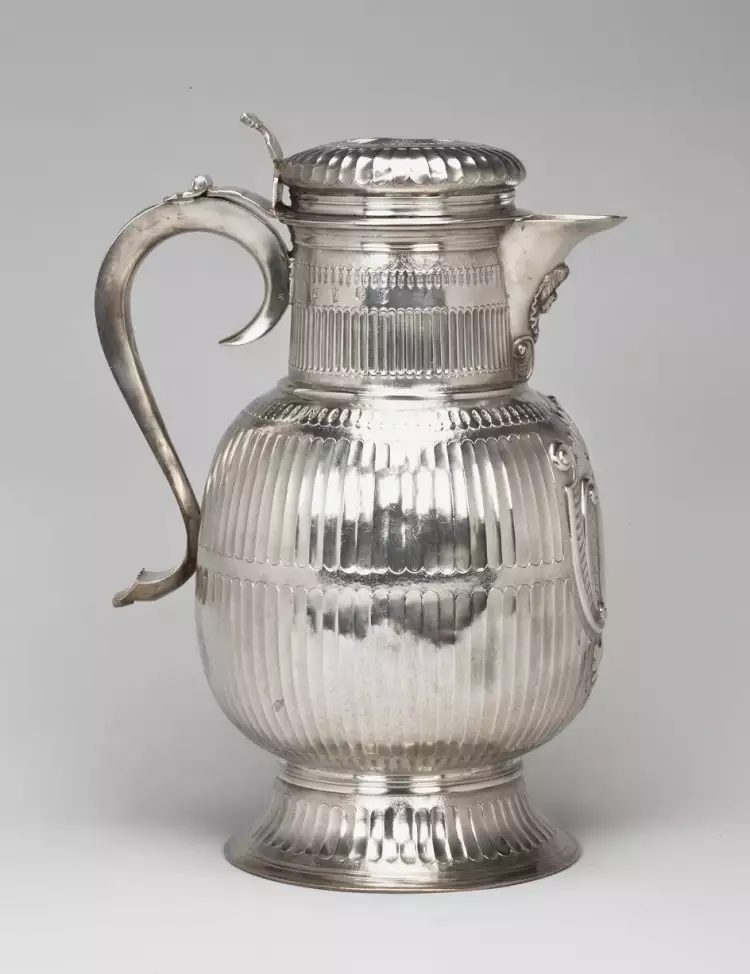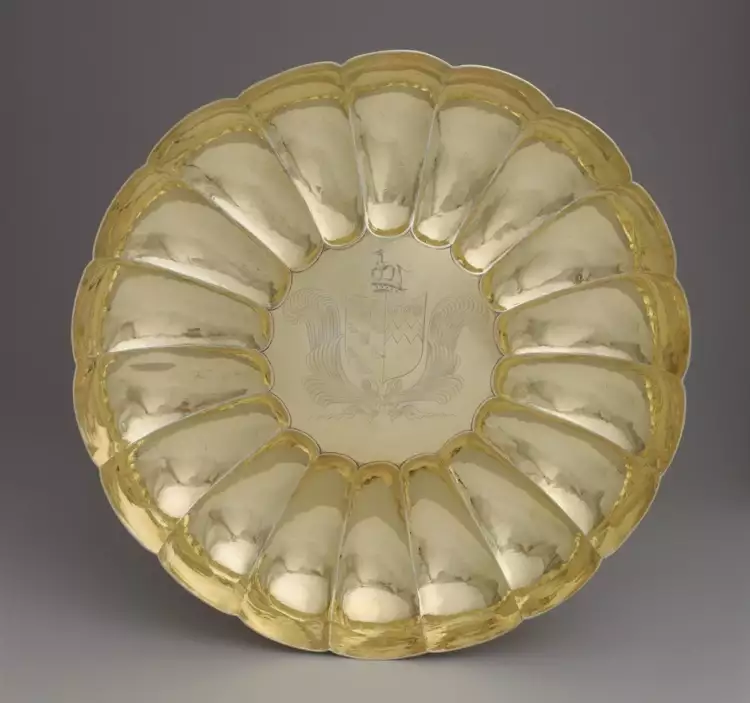
English Silver Tableware - History, Fashion, and Styles
English Silver Tableware features a variety of styles. The fashion for dishware design has changed drastically over several centuries. The technology of processing precious metals in Great Britain has always been at a high level, but the finishing of English silverware depended on the popular trends in Europe. Wealthy patrons imported tableware from France and Germany, while London jewelers copied the styles that were in demand.
 English Silver Tableware. Wine fridge with Earl of Scarsdale coat of arms, 1726-1727
English Silver Tableware. Wine fridge with Earl of Scarsdale coat of arms, 1726-1727
English silver tableware was considered a great treasure in British households as it could be melted down or pawned in difficult times. In the early Middle Ages, cups, jugs, and plates made of precious metals were a privilege of noble families - a detailed description of silverware can be found in the inventory of Lord Chancellor Walter de Merton, dated 1277. The demand for such items began to grow only in the 17th century due to the stabilization of the political situation, the growth of people's incomes, and the expansion of the middle class.
 English Silver Tableware. Salt shaker with lid, 1584
English Silver Tableware. Salt shaker with lid, 1584
British Silver Tableware in the 17th-18th centuries
Antiquarian collecting of English silverware began only in the second half of the 19th century. Before that time, the artistic value of these items was not taken into account, and old pieces were considered material for melting down. Sometimes, the old decorations were removed from the objects and replaced with new ones to follow the fashion. A unique collection of English silver tableware is held in the Hermitage Museum, as the imperial family and Russian nobility cherished foreign luxury items.
 English Silver Tableware. Jug, 1697-1698
English Silver Tableware. Jug, 1697-1698
In Great Britain during Oliver Cromwell's time, a huge number of family services were destroyed since both sides needed money to fund the civil war. The Puritans were against any excesses, so the silverware from this period is known for its functionality, durability, and extreme simplicity in design.
 English Silver Tableware. Saucer, 1664-1665
English Silver Tableware. Saucer, 1664-1665
Baroque style was popular among the French and German nobility, but it only arrived in England with the restoration of Charles II to the throne in 1660. Massive, richly decorated items with intricate floral ornaments, bird figures, and cupids came into fashion. The attributes of royal dinners at that time were impressive in their size - the weight of Charles Kendler I's wine cooler reached 220 kg.
 English Silver Tableware. Wine fridge, 1734-1735 гг.
English Silver Tableware. Wine fridge, 1734-1735 гг.
The restoration of the monarchy led to the emergence of a new nobility. The king rewarded his loyal followers, and the newly minted aristocracy actively bought luxury items. Soon, jewelers faced a shortage of silver, which led to the appearance of Queen Anne's style characterized by an abundance of smooth surfaces and modest engravings with heraldic motifs.
 English Silver Tableware. Queen Anne style teapot with oven rack and table, 1724-1725
English Silver Tableware. Queen Anne style teapot with oven rack and table, 1724-1725
In the 1730s, simplicity became tiresome to the wealthy public, and decorative and fanciful motifs came into fashion. The discovery of American deposits partially resolved the material shortage issue, and English jewelers adopted the Rococo style from their French colleagues, incorporating an abundance of flowers, shells, and leafy scrolls. The British were more restrained in their works and avoided excessive extravagance. A characteristic feature of English silverware was the use of chinoiserie decoration with exotic scenes and botanical motifs.
 English Silver Tableware. Chinese style teapot, 1757-1758
English Silver Tableware. Chinese style teapot, 1757-1758
After 1760, Neoclassicism replaced Rococo. The movement gained popularity due to archaeological excavations in Pompeii and the frequent trips of British nobility to the continent, where travelers were fascinated by ancient ruins. The architect and designer Robert Adam had a significant influence on the jewelry industry. Master craftsmen reproduced motifs from his drawings in their works, and finishing with columns, paters, and laurel wreaths became fashionable. Simple and affordable tableware with thin walls became popular among the middle class.
 English Silver Tableware. Punch bowl, 1806
English Silver Tableware. Punch bowl, 1806
Victorian Silver Tableware
The decline of Neoclassicism occurred in the 1810s. The public grew tired of cold elegance, and there was an increased demand for massive and colorful table settings. The classical style remained relevant, but objects became heavier and more monumental. Decorations included ribbons, grapevines, and Egyptian symbolism. North and Central America supplied a vast amount of cheap silver, and jewelers' imagination knew no bounds.
 English Silver Tableware. Gilded tea service items, 1813-1814
English Silver Tableware. Gilded tea service items, 1813-1814
Renowned master silversmiths:
- Peter Bateman.
- Paul Storr.
- Philip Rundell.
- Nathaniel Mills and his son.
- Edward Farrell.
With the development of technological progress in Great Britain, numerous factories emerged, producing inexpensive silver tableware, but mechanical rolling and stamping had a negative impact on the product's quality. Affluent individuals preferred to place individual orders at renowned workshops. Jewelers and silversmiths adapted to the clients' tastes and often precisely copied designs from previous centuries using reproductions.
 English Silver Tableware. Coffee pot, 1851-1852
English Silver Tableware. Coffee pot, 1851-1852
As the Victorian era drew to a close, Art Nouveau arrived from the continent. The decor featured naturalistic motifs, and tableware was adorned with images of plants, animals, and humans. Restraint was no longer a concern - subtlety was sacrificed for opulence and extravagant beauty. Most manufactories were located in London, with Birmingham serving as a supplier of small table settings items: tableware, napkin rings, sugar tongs, toothpick boxes.
 English Silver Tableware. Saucer, 1870
English Silver Tableware. Saucer, 1870
Technological advancements and the accelerating pace of life in the 20th century made silver an uneconomical material for making tableware. Fashionable restaurants opted for ceramic table settings, which required less labor-intensive cleaning and care. English silver tableware remains in demand among collectors worldwide. Among the lots of antique auctions, Very Important Lots, one can find a diverse array of table decorations from the shores of Albion.
 Genre of Nude in Painting: Evolution and Historical Trends of the Nude Style
Genre of Nude in Painting: Evolution and Historical Trends of the Nude Style  Mythological genre is the captivating world of ancient myths and legends
Mythological genre is the captivating world of ancient myths and legends  Alberto Giacometti was a great sculptor of the 20th century who relentlessly shattered the stereotypes of art in search of creative self-expression
Alberto Giacometti was a great sculptor of the 20th century who relentlessly shattered the stereotypes of art in search of creative self-expression  Hermann Historica Auction: Kunst, Antiquitäten & Antiken
Hermann Historica Auction: Kunst, Antiquitäten & Antiken  The most famous Orthodox icons
The most famous Orthodox icons  Animalism is a popular genre in painting from prehistoric times
Animalism is a popular genre in painting from prehistoric times  The top 10 most famous photographers in the world - the best photo artists of all time
The top 10 most famous photographers in the world - the best photo artists of all time  Expressionism in interior design - the style of freedom and youth
Expressionism in interior design - the style of freedom and youth  Emerging Color and Material Trends in Architecture for 2023
Emerging Color and Material Trends in Architecture for 2023  Caravaggism: The Struggle of Light and Darkness
Caravaggism: The Struggle of Light and Darkness